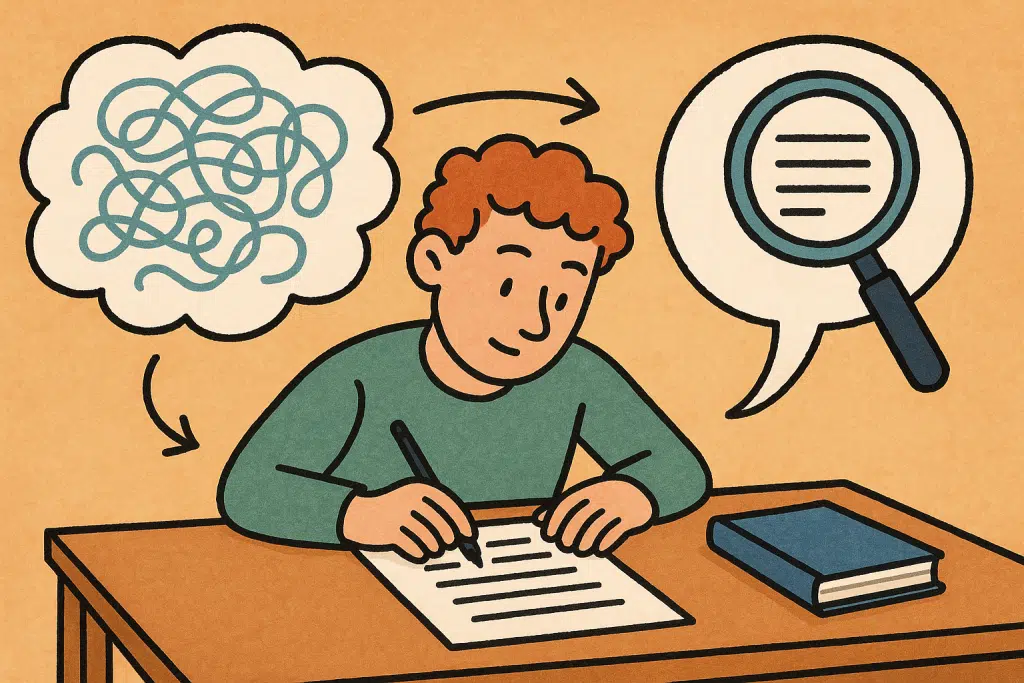Writing Can Clarify Without Explaining
Isabella Lewis July 31, 2025
When writing can clarify without explaining, readers grasp your idea instantly—without extra fluff. In 2025, minimalist clarity is redefining storytelling, technical writing, and content strategy.

Why Minimalist Clarity Is the Emerging Trend
Minimalist writing refuses unnecessary detail. It trusts readers to connect the dots. As explained in literary minimalism: “readers are expected to take an active role … based on oblique hints and innuendo”.
In an era overloaded with information, concise prose wins. One writer describes minimalist writing as delivering impact in just a few drops—like perfume.
AI content creators and serious authors alike are embracing clarity through subtraction, not amplification: less filler, more meaning.
How Writing Can Clarify Without Explaining: Core Principles
1. Use Precision Instead of Jargon
Avoid vague language and filler words. Specificity is clarity. For example, compare:
- Vague: “We met later.”
- Better: “We met at 3 PM at the café.”
This sharpens meaning and helps readers visualize instantly.
2. Use Outlines and Signposting
Outlines offer a scaffold for clarity. Structuring ideas as thesis plus three supporting points makes the logic obvious to readers (and yourself). Likewise, signposting signals transitions clearly: “First … Secondly … Finally …”.
3. Write Actively, Cut the Fat
Active voice helps writing flow: “Jane asked Joe” beats “Joe was asked by Jane.” It keeps prose tight, dynamic, relatable.
4. Let Readers Fill in Gaps
Clarify without explaining means trusting readers. Minimalist techniques encourage reader inference—triggering deeper engagement.
Examples: Real-World Minimalist Clarity
- Product descriptions now favor ultra‑concise benefits rather than long explanations.
- Tech journalism uses punchy headlines—no fluff: AI writing improves clarity vs. The latest tools with deep learning to optimize content distribution.
- Scientific blogs assume informed users, supplying only new insight rather than re‑explaining basics.
More broadly, minimalism as mindset—removing noise, amplifying purpose—has crossed into writing. Writers like Utkarsh Narang stress that minimalism is about intentional focus, not deprivation.
Practical Guide: Apply Minimalist Clarity to Your Writing
A. Set Your Thesis Clearly
Before writing, define your core message in one sentence. Use three supporting points max. This structure promotes coherent delivery and prevents over‑explaining.
B. Outline First
Draft a simple outline:
- Thesis
- Point A
- Point B
- Point C
Each paragraph should directly serve one point.
C. Trim Redundant Phrasing
In editing, eliminate flabby constructions—like due to, in order to, the fact that. Prefer: because, to, that.
D. Use Active Voice
Rewrite passive sentences into active form. This tightens rhythm and clarity.
E. Trust the Reader
Allow details to be implied. Instead of detailing a whole process, give enough context to let the reader infer—without burdening them.
F. Iterate Your Draft
Minimalism often requires revision. Write freely, then refine. Clarity often emerges during editing, not initial drafting.
Benefits of Embracing This Approach
- Efficiency: Minimalist writing conveys ideas in fewer words; readers consume faster.
- Engagement: Readers appreciate language that assumes intelligence—making reading feel intelligent and collaborative.
- Memory: Clear, specific statements stick longer than lengthy exposition.
- Trust: Clear writing builds credibility; vague writing erodes it.
When Over‑Minimalism Hurts Clarity
Beware of being too cryptic. If readers lack background, too much inference leads to confusion. You must know your audience: for novices, explain a bit more; for experts, trust them to fill in context.
Balance is essential: provide markers and context up front, then step back.
Case Study: Minimalist Style in Tech Blogging
In early 2025, tech blogs shifted from long-form rambling intro to straight‑to‑point articles. Rather than elaborate history sections, they open with headlines like: “AI summarization slashes editing time” and the first paragraph states the impact. Readers now expect to find real insight within the first 50 words, a reflection of minimalist clarity in action.
Summary Table: Contrast Clause-by-Clause
| Conventional Writing | Minimalist Clarity Approach |
|---|---|
| Lots of context and explanation | Key point plus concise cues |
| Passive voice and long sentences | Active voice, tight syntax |
| Heavy use of filler words and phrases | Specific language and imagery |
| Complete descriptions for every step | Trust reader to infer between concise anchor points |
| Redundant transitional markers | Signposts used sparingly, but deliberately |
Why Writing Can Clarify Without Explaining Matters in 2025
With attention spans shrinking and information overload rising, writing that clarifies quickly—without over‑explaining—is essential. Whether you’re crafting product descriptions, blog entries, whitepapers, or social media copy, minimalist clarity lets your ideas shine through without verbosity.
The modern reader processes thousands of messages daily. Studies show people spend less than 15 seconds scanning content before deciding to engage. This reality has killed the traditional approach of exhaustive explanation.
Today’s audiences want immediate value, not lengthy preambles. Apple doesn’t explain processor specifications; they say “blazingly fast performance.” Tesla skips engineering details for “400 miles of range.” These brands understand that clarity often means choosing what not to say.
The art lies in knowing your audience’s baseline knowledge and building precisely from there. Over-explanation insults intelligence; under-explanation creates confusion. Technology amplifies this trend—search engines reward quick answers, social algorithms favor immediate engagement, and email platforms highlight concise messages.
This approach demonstrates confidence in both your ideas and your audience. The challenge is developing editorial discipline through ruthless cutting. The payoff is writing that respects time and maximizes impact.
Final Tips for Writers
- Begin with a clear one-sentence thesis.
- Outline before writing.
- Use active, specific language.
- Cut filler and redundancies.
- Trust the reader—don’t over‑explain.
- Revise relentlessly.
Conclusion
In 2025, writers are discovering that writing can clarify without explaining—that powerful, meaningful prose doesn’t need to spell out every detail. Minimalism doesn’t mean cryptic; it means intentional. It means giving just enough so readers think, infer, and engage. Use outlines, specific language, active sentences, and powerful brevity to make every word count.
This shift reflects how modern readers consume content. They don’t want to be told what to think—they want to be invited to think. The most memorable writing doesn’t explain everything; it illuminates just enough. It creates moments where readers think “Yes, exactly,” not because you’ve told them what to feel, but because you’ve created the conditions for them to feel it themselves.
By refining your writing in this way, you create content that reads effortlessly—and resonates deeply.
References
Rowe, C. (2019). Bring Clarity to Your Thinking by Writing. Writing Cooperative. Retrieved from https://writingcooperative.com
Mintz, S. (2022). Writing Is Thinking. Inside Higher Ed. Retrieved from https://www.insidehighered.com
ExplorationsofStyle.com (2011). Using Writing to Clarify Your Own Thinking. Retrieved from https://explorationsofstyle.com







